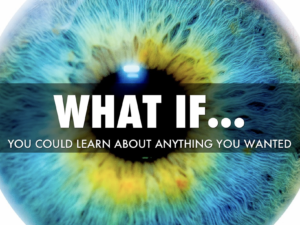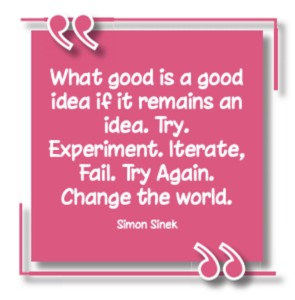The Process of Genius Hour
Project-based learning through Genius Hour provides a structure to help students succeed.
There are three main components to Genius Hour.
- Research: Students must research something. Students cannot spend time going over the information they already know. The key is learning and as a bi-product of this, learning and refining research skills.
- Create: Students have to create something. They need to have something ‘to show’ for their time.
- Present: Students have to present something. At the end of the time frame given, students give a verbal presentation to explain their process and learning.
When starting out using Genius Hour in your classroom, it is useful to stick closely to the process outlined. Once you become more confident you can and most certainly will modify and adapt the process to suit both your students and the learning outcomes.
Introducing Genius Hour
A great place to start is with a discussion about what it means to be a genius. If students are going to spend time each week being ‘geniuses’ defining what this means and how it will apply to them is essential.
Chat about what are some of the attributes of a genius. Not only are they smart, they are also insightful, creative, persistent and continuous learners. What other attributes might your students add? Brainstorm a list of attributes and actions that students consider to be ingenious.
Advertise the fact that students will be engaging in an exciting Genius Hour time with posters and teasers. I saw a huge poster in a classroom saying, “Genius Hour is Approaching” and another that said, “Genius Hour – what impact do you want to make?”
The Seven Steps
Genius Hour is based on a process of seven steps. These steps provide a clear structure and pathway from beginning to end.
 Find your Passion
Find your Passion
2. Plan, Plan, Plan
3. Make a Pitch
4. Project
5. Create a Product
6. Presentation Day
7. Ponder
Let’s look at each step in more depth.
Step 1: Find Your Passion
Start by discussing, “What does it mean to be passionate about something?” This links with the concept of joy and happiness. Invite students to brainstorm things they are passionate about. What do they love doing for fun?
Create a wonder wall and invite students to add questions they have about the world. What are they curious about? What do they wonder about? This may serve as an idea generator or simply spark inspiration.
For some students, this step can be a challenge as they are not used to being able to choose in the school environment. For others, it is the most natural and easiest step to take.
Step 2: Plan, Plan, Plan
Encourage and provide time for students to plan out their project. This is one of the most important steps for success in Genius Hour.
Stephen Covey, educator and author, advocated for ‘starting with the end in mind.’ Have students become clear on their end goal and plan backward from there. If that is where they want to end up in x number of weeks, what will they need to achieve along the way? Ultimately at this step, students will create a step by step plan to know exactly what they need to do each week during Genius Hour time.
Of course, this part, for many students is a piece of the ultimate learning, such as planning too much or too little, knowing your own limitations and strengths or being able to predict potential problems or challenges. Be mindful to allow students to have some of these learnings.
Just as great scientists and explorers start with a question., it is important for each Genius Hour project to have a driving or guiding question. This needs to be something that is not Googleable, yet can be researched.
Step 3: Making a Pitch
The purpose of making a pitch is for students to get further clarity, and feedback and to gain approval for their project. There are a couple of ways this step is typically conducted.
The pitch could be a short verbal presentation that helps the student to clarify their project as well as gain valuable feedback from their peers or it may be a proposal submitted to the teacher for approval. It could even be a combination of both.
This stage can either happen before or after the planning stage – depending on how you wish to structure this in your classroom.
 Step 4: The Project
Step 4: The Project
This is where students get on with it! Students will be researching, working with experts, creating prototypes, and creating and putting their action plan into place.
Students may be accessing information online, through apps, books, magazines, surveys, phoning or skyping experts etc.
This is when your classroom will get extra busy. With so many different and varied projects going on, having a set of rules may be useful. Ponder
Step 5: The Product
This is the step where students show the bigger application of their project. The impact and difference they have made to themselves, others, the environment or the planet.
Questions at this stage include: What did you create? What can you show to demonstrate your learning? Does your product match up with your initial planning and goal?
It needs to show the effort, thinking, time and consideration of others.
The product is designed to be shared with others. The final product may, and I believe should be shared to the world via YouTube, some form of prototype, a digital book, website or recorded demonstration etc.
 Step 6: The Presentation
Step 6: The Presentation
The opportunity to share the product with an authentic audience is a huge key to the success of Genius Hour. It shows students that learning and the impact they can have is beyond the walls of a classroom, school gates, the community, town or even country borders! It makes the learning more relevant, and meaningful and gives it far more purpose.
This is the stage where all the learning and hard work comes together. It is an opportunity to present and share wins, failures, learnings and challenges with a short talk.
A quick search on Pinterest or Google and you will find a wonderful graphic of 101 Ways to Show You Know. Allowing students to show their learning in many different ways provides wonderful differentiation to the classroom.
Step 7: Ponder
After the event, provide time for students to ponder on their project. Encourage them to go back and revisit their goals and analyse what contributed to their success. Invite them to reflect on their learnings and make applications to their lives beyond the school gates, and their own futures. Also, go back to the original brainstorm of the attributes of a genius and link this to students’ personal learnings and attributes used throughout this process.
The transference of learning to their life is often where the best learning happens.

For more information on webinars, protocols, examples and templates, check out Karen’s book Project Genius at www.spectrumeducation.com
Tags: Authentic Learning, Genius Hour, Karen Tui Boyes, Life long learning, Passion Projects, Project Genius
Published on Monday, April 4th, 2022, under Curriculum design, Learning, Teacher Effectiveness, Transformational Learning
